When using a test pen, it's important to touch the metal part at the end of the pen with your finger and position the small window so that it is backlit and facing you. This allows you to accurately observe the brightness of the light, preventing misjudgment due to excessive light. Refer to the image below for proper usage.
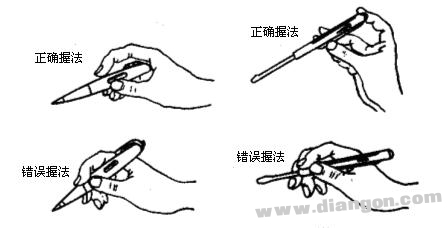
When testing a charged body with an electric pen, the current forms a circuit through the charged body, the pen, your body, and the ground. If the potential difference between the charged body and the ground exceeds 60 V, the bulb inside the pen will glow. The low-voltage electroscope is designed to work within a voltage range of 60~500V.
Precautions:
- Before use, always test the electroscope on a known power source to ensure it is functioning properly.
- During testing, gradually approach the object being measured until the tube lights up; never directly touch the object.
- Always make sure your finger is in contact with the metal part at the end of the pen. Otherwise, you may incorrectly identify a charged body as uncharged.
- Avoid touching the metal tip of the pen to prevent electric shock.
2. Electrician Knife

When using an electrician knife:
- Never use it for live work to avoid electric shock.
- Keep the blade edge facing outward and be careful not to cut yourself.
- When cutting wire insulation, maintain a small acute angle between the blade and the wire to avoid damaging the wire itself.
- After use, fold the blade into the handle for safe storage.
3. Screwdriver

When using a screwdriver:
- For large screwdrivers, grip the handle with your thumb, forefinger, and middle finger, and press your palm against the end of the handle to prevent slipping.
- For smaller screwdrivers, hold the handle with your thumb and middle finger, and use your index finger to apply pressure to the end.
- For long screwdrivers, use your right hand to press the handle while holding the middle part with your left hand (not around the screw) to prevent slipping.
- Precautions:
- Never touch the metal rod of the screwdriver when working on live circuits to avoid electric shock.
- Do not use a metal rod to straighten the screwdriver on top of the handle.
- Cover the metal rod with an insulating tube to prevent contact with the body or adjacent live parts.
4. Wire Cutters

Wire cutters are versatile tools used for bending or clamping wire ends, tightening nuts, cutting wire insulation, and cutting wires or cables. Each function is shown in the figure above.
- Precautions:
- Inspect the wire cutters before use to ensure they are insulated, especially during live working.
- Avoid using the knife edge to cut two wires with different potentials simultaneously (e.g., phase and neutral lines), as this can cause short circuits.
5. Needle-Nose Pliers
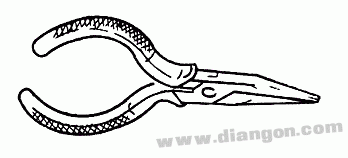
Needle-nose pliers are ideal for working in tight spaces due to their sharp tips. They can be used to cut small wires, hold screws, nuts, washers, and wires, or shape single-strand wires. If used for live working, ensure the insulation is intact and avoid contact with the human body or other live parts.
6. Diagonal Pliers
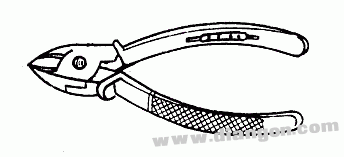
Diagonal pliers are designed for cutting wires and cables. Choose the appropriate size based on the material's thickness and hardness.
7. Wire Strippers
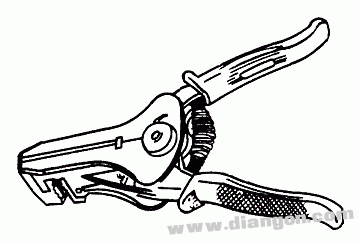
Wire strippers are used to remove fine wire insulation. To use them:
- Measure the length of insulation to be removed.
- Place the wire in the corresponding slot (slightly larger than the wire diameter).
- Squeeze the handles to strip the insulation.
8. Soldering Iron
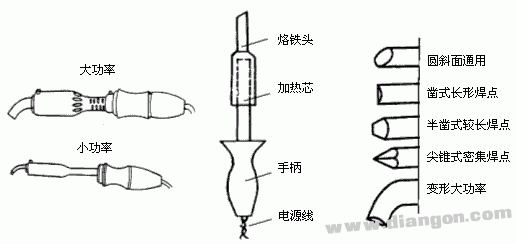
Before soldering, remove the oxide layer from the soldering tip and perform a tinning process. This ensures a thin layer of tin remains on the tip, preventing oxidation and improving heat conduction.
There is no strict rule for gripping the soldering iron—choose a method that is comfortable and efficient. Common methods include the pen grip and the fist grip.
When soldering, always use solder and flux. Solder is typically made of tin or rosin-based flux.
Basic Requirements for Soldering:
- The solder joint must be strong and fully penetrated.
- The surface should be smooth and free of defects.
- Avoid "virtual welding" (due to poor cleaning or insufficient flux) and "sand welding" (due to low temperature or short time).
Soldering Precautions:
- Check the power cord before use to ensure it is undamaged.
- Use safety measures like anti-leakage protection when soldering sensitive components.
- If the tip becomes oxidized, do not force it.
- Do not rub or knock the tip if it is difficult to solder.
- Avoid prolonged soldering on small components to prevent damage.
- After soldering, unplug the iron and place it on a metal stand to avoid burns or fires.
Single Mode Fiber Optic Patch Cord
Single Mode Fiber Optic Patch Cord,Wire Grade Fiber Optic Patch Cords,Audio Fiber Optic Patch Cords,Single Mode Fiber Optic Patch Cords
Shenzhen Jingtu Cabinet Network Equipment Co., LTD , https://www.jingtujigui.com